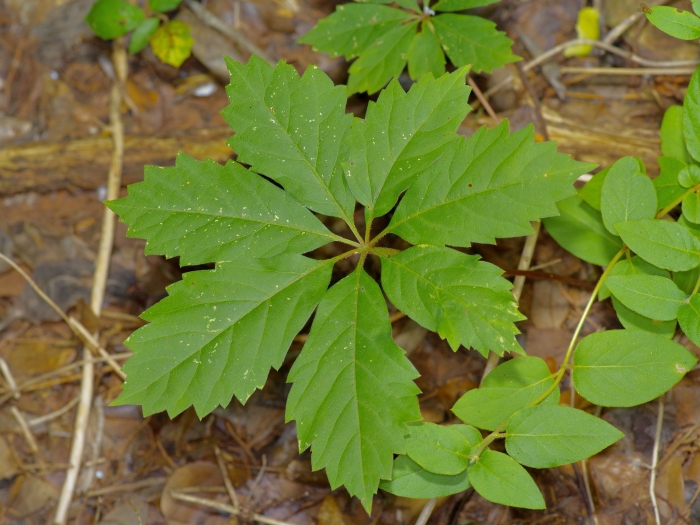Virginia Creeper
(Parthenocissus heptaphylla)
Virginia Creeper (Parthenocissus heptaphylla)
/
/

Michelle W.
CC BY 4.0
Image By:
Michelle W.
Recorded By:
Copyright:
CC BY 4.0
Copyright Notice:
Photo by: Michelle W. | License Type: CC BY 4.0 | License URL: http://creativecommons.org/licenses/by/4.0/ | Rights Holder: Michelle W. | Publisher: iNaturalist | Date Created: 2021-06-19T02:31:12-07:00 |
























Estimated Native Range
Summary
Parthenocissus heptaphylla, commonly known as Virginia Creeper, is a deciduous vine native to woodland edges, thickets, and rocky outcrops in eastern and central North America. It can rapidly grow to 30-50 feet (9-15 meters) in length and uses small adhesive disks at the tips of tendrils to cling to surfaces. This vine is known for its palmately compound leaves with five leaflets and its ability to turn a brilliant red in the fall, adding seasonal interest to gardens and landscapes. The inconspicuous greenish flowers bloom in late spring to early summer, followed by dark blue to black berries that are attractive to birds.
Virginia Creeper is valued for its fast growth, making it an excellent choice for covering walls, trellises, or fences. It is also used for erosion control on slopes. This plant thrives in a range of conditions, preferring moist, well-drained soils but tolerating a variety of soil types, including clay. It can grow in full sun to full shade, though the best fall color typically occurs in full sun. While generally low-maintenance, it can become aggressive if not managed properly and may require pruning to keep it in bounds. It is also important to be aware that the berries and leaves can be toxic if ingested, and the sap may cause skin irritation in some individuals.CC BY-SA 4.0
Virginia Creeper is valued for its fast growth, making it an excellent choice for covering walls, trellises, or fences. It is also used for erosion control on slopes. This plant thrives in a range of conditions, preferring moist, well-drained soils but tolerating a variety of soil types, including clay. It can grow in full sun to full shade, though the best fall color typically occurs in full sun. While generally low-maintenance, it can become aggressive if not managed properly and may require pruning to keep it in bounds. It is also important to be aware that the berries and leaves can be toxic if ingested, and the sap may cause skin irritation in some individuals.CC BY-SA 4.0
Plant Description
- Plant Type: Vine
- Height: 30-50 feet
- Width: 10-15 feet
- Growth Rate: Rapid
- Flower Color: Green
- Flowering Season: Spring, Summer
- Leaf Retention: Deciduous
Growth Requirements
- Sun: Full Sun, Part Shade, Full Shade
- Water: Medium
- Drainage: Medium, Fast
Common Uses
Erosion Control, Groundcover, Low Maintenance
Natural Habitat
Woodland edges, thickets, and rocky outcrops in eastern and central North America
Other Names
Common Names: Woodbine, Virginia creeper
Scientific Names: , Parthenocissus heptaphylla, Ampelopsis heptaphylla, Ampelopsis heterophylla, Parthenocissus heptaphylla, Parthenocissus quinquefolia var. heptaphylla, Parthenocissus texana, Psedera heptaphylla, Psedera texana, Vitis hederacea var. texana
GBIF Accepted Name: